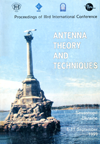FDTD analysis of log-periodic flat dipole antennas
DOI:
https://doi.org/10.1109/ICATT.1999.1236239Abstract
LPDA are now widely used for TV, broadcasting and communication in frequency range 0.1…4 GHz. The stand-point of the advantages of this type of antennas is the possibility to achieve permanently high gain in broad band. Up to the early 90th full-series production of LPDA use the technology of welding of metal tubes of different length and diameters. Obtained metal contacts were not reliable or otherwise were too expensive. Especially this regards to the cases when antenna gain is 10dB and more in broad band. The step forward in LPDA-building was made by proposal of new technology [1], which al-lows to increase reliability of antenna and to reproduce the geometry parameters of LPDA with precision not worth than 0.1 mm. Before, most of investigators used method of moments for LPDA modelling. Antenna model was consist of infinitely thin wires connected by hypothetical transmission line in free space. Results were obtained by numerical solution of integral equation for the currents and voltages on vibrators.
In this paper a new analysis based on FDTD method is presented.
References
Dubrovka, F.F.; Glushenko, V.M.; Kuprij, A.M. UA Patent No. 1.
Barke, G.J.; Poggio, A.J. The Numerical Electro-magnetic Code (NEC2). Livermore, CA: Lawrence Livermore Laboratory, 1980.
Yee, K.S. Numerical solution of initial boundary value problems involving Maxwell’s equations. IEEE Trans. AP, May 1966, Vol. 14, p. 302-307.
Mur, G. Absorbing boundary conditions for the finite difference approximation of the time-domain electromagnetic field equations. IEEE Trans. EMC, Nov. 1981, Vol. EMC-23, p. 377-382.
Luebbers, R.J.; Kunz, K.S. A finite-difference time-domain near zone to far zone transformation. IEEE Trans. AP, Apr. 1991, Vol. AP-39, p. 429-433.
Hlushenko, V.N.; Dubrovka, F.F.; Kuprii, A.M.; Martynyuk, S.E.; Shrenk, A.E. New Log-Periodic and Quasi-Periodic Dipole Antennas of the VHF-UHF Range. Radioelectronics and Communications Systems, 1998, Vol. 41, No. 8, p. 7-17.

